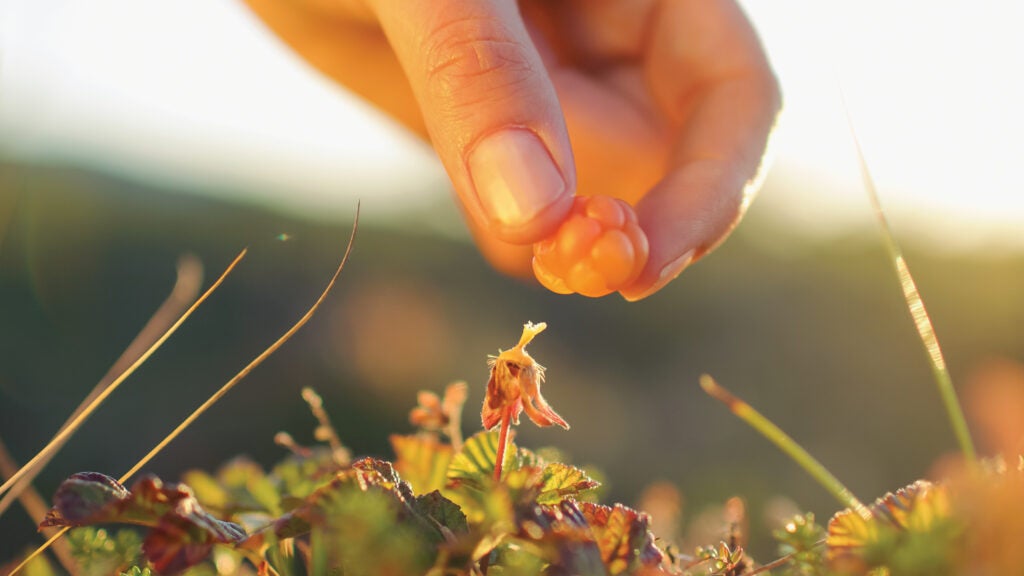
After parking our flat-bottom riverboat towards the arduous mudbank on the tidal flats, we stroll simply over a mile. It’s a 65-degree Alaska summer time day. The solar radiates warmth immediately above us, and a slight breeze retains the mosquitoes away from our arms, face, and mouth—largely. We’re crossing the tundra. Skinny grass blades bristle the bottoms of our pant legs. With each step, we sink 5 inches into the squish of lichen and generations of composted vegetation. We’re in Unalakleet, a fishing and searching group on the coronary heart of the Norton Sound in northwestern Alaska. My husband and I are searching for fields of orange, the place the work begins.
We bend over, choose, get up, step, bend over, choose, get up, and on and on and on—all in an effort to fill our white plastic buckets with a tart, candy berry the Inupiat name the aqpik. Its taste may greatest be described as a cross between an apricot, a lemon, and an orange, however the exact sensation of the seedy, juicy aqpik touching the tongue and throat is exclusive. Consuming simply half a cup of aqpik supplies as a lot vitamin C as 4 oranges. We retailer the berries in ziplock freezer baggage, thawing them months later, when the winter wind blows 20 miles per hour for days on finish and we’d like a bit sunshine pick-me-up.
Plucking the velvety, fecund berry from a stem that shoots out of the thick, squishy carpet is like selecting a ripe raspberry. However it’s additionally nothing like that, as a result of we’re in coastal Alaska, and the whole lot value consuming right here grows low to the bottom in acidic soil. Ripening within the straight-down July warmth, the person berries attain up from the earth. Their large, forest-green leaves soak within the solar’s rays. The berry sits on the high of the proud, top-heavy plant, virtually shouting at you with colour.
As I bend over to pluck three aqpiit from their stems, I see one thing I’ve by no means seen earlier than. In the course of a patch of rust-red moss the scale of my softball mitt, moist, shiny polka dots catch my eye. They appear nearly tropical, sort of alien. My face relaxes and my eyes widen—I’ve discovered one thing new on this land the place I grew up. Setting my bucket down on some agency lichen, I bend my legs for a better look.
Fuchsia polka dots lined in a transparent liquid beckon. They’re seated atop eyelash-size fuchsia stems. Fifty minuscule rays of goo splay out from a neon green-yellow paddle leaf smaller than my pinkie nail. I consider Dr. Seuss. I really feel the smile behind my eyes dance to my face, by way of my jaw, my neck, and right down to my stomach. The place I’d as soon as been deep within the area of meditation particular to selecting berries, I’m abruptly in marvel. Nothing else issues. It’s simply me and this tiny being, no taller than the tip of my finger, with six of its companions taking pictures out from a comforting, tender sphagnum.
What’s the liquid dot on every stem? Is it poisonous? Will it burn my pores and skin?
I contact it anyway. Feeling a bit sorry for disturbing the little plant on this sizzling, sunny, good July day, I apologize aloud. Certain sufficient, the liquid on my fingertip is sticky.
Ooh, are you carnivorous?
I look at one other neon inexperienced paddle with one other 50 polka dots splayed out. A tiny bug is caught on a couple of stems, additionally coated in goo.
We have now carnivorous vegetation in Unalakleet.
I holler to my husband: “Come look!”
He stands up from his selecting crouch, smiles his distinctive smile, and walks over to me.
I level on the plant, inform him I believe it’s carnivorous, that I’ve by no means seen it earlier than. He hovers over and I’m joyful to have one other individual to get pleasure from this second with, increasing the expertise. By individually connecting with this tiny plant, we turn into extra related to one another.
Once we arrive residence a couple of hours later, I place our plastic buckets, filled with berries, on the kitchen desk. Then I instantly google “carnivorous vegetation in Alaska.” I study that the one I noticed is named a sundew. It dietary supplements its want for nitrogen and different vitamins by catching bugs, releasing enzymes to digest them, and extracting what it will probably’t get from the tundra soil. The sundew is commonly present in boggy, moist floor, like our tidal flats.
My physique buzzes. My cheeks are tight with a smile, my eyes relaxed. In the course of my kitchen, I image the spunky little plant that reaches out from the moss, ready, hoping, and luring tiny winged pests.
Drained from strolling, and glad with our haul, my complete physique provides thanks, understanding this land can nonetheless shock me.
Supply Hyperlink : hagportfolio.com

